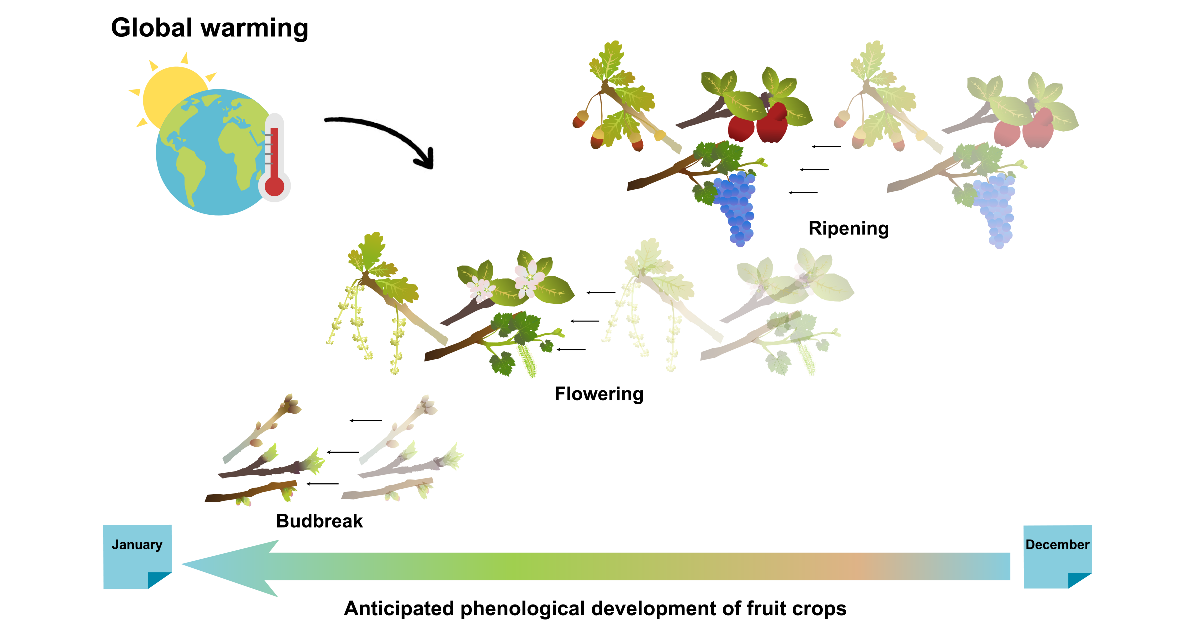Climate Change and Plant Phenology: Challenges for Fruit Production
A special issue of Agriculture (ISSN 2077-0472). This special issue belongs to the section "Crop Production".
Deadline for manuscript submissions: 31 December 2025 | Viewed by 1740

Special Issue Editors
Interests: viticulture; fruit quality; abiotic stress management; tree crops; cultivar selection; production techniques
Special Issues, Collections and Topics in MDPI journals
Interests: tree crops; grapevine; dormancy; budbreak; gene expression; molecular regulation
Interests: agricultural and food econonomics; agricultural innovation and technology; rural development; resilience; agrifood supply chain management; multi-criteria decision making
Special Issues, Collections and Topics in MDPI journals
Interests: grapevine; fruit crop dormancy; abiotic stress tolerance; spring frosts; plant physiology; molecular biology
Interests: plant protection; climate change; ecobiology; biocontrol; pollinators health
Special Issue Information
Dear Colleagues,
It is well known that climate change significantly impacts plant phenology. During summertime, the vegetation period can shift, affecting the reproductive cycle (i.e., flowering, veraison, ripening) and inducing changes in the quality of the fruits. Alongside the consequences of the exacerbation of summer stress, winter warming can cause significant damage to bud dormancy, compromising tree crop production. Bud break and, in some cases, flowering during autumn and wintertime have become common in mild winters, and the expected impact on the local economy could be catastrophic.
Thus, new strategies are urgently needed for tree crop management (e.g., pruning systems and/or timing), including considering new fruit trees for cultivation (different species and/or different cultivars) or new regions for tree crop production. Of course, we also need to quantify the socio-economic impact of phenological disfunction on the production sector, setting up strategies to preserve the sustainability of the agricultural sector.
This Special Issue focuses on the effect of climate change on tree crop systems and will include interdisciplinary studies merging agriculture with economy, molecular biology, ecophysiology, and climatology. We encourage research articles studying different economically important tree crops as well as minor/new species from different points of view. All types of articles, such as original research, opinions, and reviews, are welcome.
Dr. Laura Rustioni
Dr. Rachele Falchi
Dr. Giulio Paolo Agnusdei
Dr. Valeria De Rosa
Dr. Mounir Kherroubi
Dr. Daniel Grigorie Dinu
Guest Editors
Manuscript Submission Information
Manuscripts should be submitted online at www.mdpi.com by registering and logging in to this website. Once you are registered, click here to go to the submission form. Manuscripts can be submitted until the deadline. All submissions that pass pre-check are peer-reviewed. Accepted papers will be published continuously in the journal (as soon as accepted) and will be listed together on the special issue website. Research articles, review articles as well as short communications are invited. For planned papers, a title and short abstract (about 250 words) can be sent to the Editorial Office for assessment.
Submitted manuscripts should not have been published previously, nor be under consideration for publication elsewhere (except conference proceedings papers). All manuscripts are thoroughly refereed through a single-blind peer-review process. A guide for authors and other relevant information for submission of manuscripts is available on the Instructions for Authors page. Agriculture is an international peer-reviewed open access semimonthly journal published by MDPI.
Please visit the Instructions for Authors page before submitting a manuscript. The Article Processing Charge (APC) for publication in this open access journal is 2600 CHF (Swiss Francs). Submitted papers should be well formatted and use good English. Authors may use MDPI's English editing service prior to publication or during author revisions.
Keywords
- tree crops
- phenology
- temperatures
- sustainability
- local economy
Benefits of Publishing in a Special Issue
- Ease of navigation: Grouping papers by topic helps scholars navigate broad scope journals more efficiently.
- Greater discoverability: Special Issues support the reach and impact of scientific research. Articles in Special Issues are more discoverable and cited more frequently.
- Expansion of research network: Special Issues facilitate connections among authors, fostering scientific collaborations.
- External promotion: Articles in Special Issues are often promoted through the journal's social media, increasing their visibility.
- Reprint: MDPI Books provides the opportunity to republish successful Special Issues in book format, both online and in print.
Further information on MDPI's Special Issue policies can be found here.










